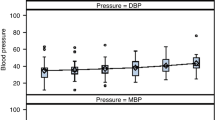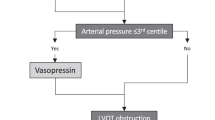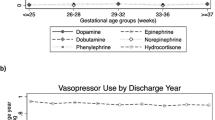Abstract
Objective
To evaluate the effect of low dose vasopressin on the hemodynamics of neonates with persistent pulmonary hypertension and catecholamine refractory shock.
Methods
This retrospective study was conducted in a level III NICU of a tertiary care teaching hospital, south India. Eighteen neonates with hypoxemic respiratory failure due to persistent pulmonary hypertension of newborn with catecholamine refractory shock were studied. Neonates were managed for hypotension with conventional inotropic support with the additional use of low dose vasopressin (LDV). Effect of vasopressin on oxygenation index (OI), blood pressure, duration of inotropic usage and survival was evaluated.
Results
Mean OI was 38.2 ± 4.9, and mean blood pressure was 30.7 ± 5.3 mmHg before the start of vasopressin. Initiation of LDV (0.0003 ± 0.0001 IU/kg/min) for a median duration 36.4 ± 17.9 h was followed by a reduction in OI (p < 0.001), control of hypotension (p < 0.001), reduction in lactic acidosis (p < 0.001) and decline in inotropic support.
Conclusions
In resource-restricted settings, LDV may be useful as a rescue therapy for persistent pulmonary hypertension of newborn with catecholamine refractory shock.
Similar content being viewed by others
References
Acker SN, Kinsella JP, Abman SH, Gien J. Vasopressin improves hemodynamic status in infants with congenital diaphragmatic hernia. J Pediatr. 2014;165:53–8.e1.
Mohamed A, Nasef N, Shah V, McNamara PJ. Vasopressin as a rescue therapy for refractory pulmonary hypertension in neonates: case series. Pediatr Crit Care Med. 2014;15:148–54.
Malikiwi A, Sasi A, Tan K, Sehgal A. Vasopressin as an adjunct therapy for pulmonary hypertension: a case report. Eur J Pediatr. 2014;173:1651–4.
Radicioni M, Troiani S, Camerini PG. Effects of terlipressin on pulmonary artery pressure in a septic cooled infant: an echocardiographic assessment. J Perinatol. 2012;32:893–5.
Scheurer MA, Bradley SM, Atz AM. Vasopressin to attenuate pulmonary hypertension and improve systemic blood pressure after correction of obstructed total anomalous pulmonary venous return. J Thorac Cardiovasc Surg. 2005;129:464–6.
Rios DR, Kaiser JR. Vasopressin versus dopamine for treatment of hypotension in extremely low birth weight infants: a randomized, blinded pilot study. J Pediatr. 2015;166:850–5.
Ni M, Kaiser JR, Moffett BS, et al. Use of vasopressin in neonatal intensive care unit patients with hypotension. J Pediatr Pharmacol Ther. 2017;22:430–5.
Walker BR, Haynes J Jr, Wang HL, Voelkel NF. Vasopressin-induced pulmonary vasodilation in rats. Am J Phys. 1989;257:H415–22.
Eichinger MR, Walker BR. Enhanced pulmonary arterial dilation to arginine vasopressin in chronically hypoxic rats. Am J Phys. 1994;267:H2413–9.
Evora PR, Pearson PJ, Schaff HV. Arginine vasopressin induces endothelium-dependent vasodilatation of the pulmonary artery. V1-receptor-mediated production of nitric oxide. Chest. 1993;103:1241–5.
Tamaki T, Kiyomoto K, He H, et al. Vasodilation induced by vasopressin V2 receptor stimulation in afferent arterioles. Kidney Int. 1996;49:722–9.
Aradhya AS, Sundaram V, Sachdeva N, Dutta S, Saini SS, Kumar P. Low vasopressin and progression of neonatal sepsis to septic shock: a prospective cohort study. Eur J Pediatr. 2020;179:1147–55.
Davis AL, Carcillo JA, Aneja RK, et al. American College of Critical Care Medicine clinical practice parameters for hemodynamic support of pediatric and neonatal septic shock. Crit Care Med. 2017;45:1061–93.
Shivanna B, Rios D, Rossano J, Fernandes CJ, Pammi M. Vasopressin and its analogues for the treatment of refractory hypotension in neonates. Cochrane Database Syst Rev. 2013;3:CD009171.
Dempsey E, Rabe H. The use of cardiotonic drugs in neonates. Clin Perinatol. 2019;46:273–90.
Konduri GG, Kim UO. Advances in the diagnosis and management of persistent pulmonary hypertension of the newborn. Pediatr Clin N Am. 2009;56:579–600.
De Boode WP, Singh Y, Molnar Z, et al. Application of neonatologist performed echocardiography in the assessment and management of persistent pulmonary hypertension of the newborn. Pediatr Res. 2018;84:68–77.
Bhat BV, Plakkal N. Management of shock in neonates. Indian J Pediatr. 2015;82:923–9.
Shivananda S, Ahliwahlia L, Kluckow M, Luc J, Jankov R, McNamara P. Variation in the management of persistent pulmonary hypertension of the newborn: a survey of physicians in Canada, Australia, and New Zealand. Am J Perinatol. 2012;29:519–26.
Steinhorn RH. Neonatal pulmonary hypertension. Pediatr Crit Care Med. 2010;11:S79–84.
Hagadorn JI, Brownell EA, Herbst KW, Trzaski JM, Neff S, Campbell BT. Trends in treatment and in-hospital mortality for neonates with congenital diaphragmatic hernia. J Perinatol. 2015;35:748–54.
Lakshminrusimha S, Keszler M. Persistent pulmonary hypertension of the newborn. Neoreviews. 2015;16:e680–92.
Nakwan N, Jain S, Kumar K, et al. An Asian multicenter retrospective study on persistent pulmonary hypertension of the newborn: incidence, etiology, diagnosis, treatment and outcome. J Matern Fetal Neonatal Med. 2020;33:2032–7.
Chandrasekharan PK, Rawat M, Madappa R, Rothstein DH, Lakshminrusimha S. Congenital diaphragmatic hernia - a review. Matern Health Neonatol Perinatol. 2017;3:6.
Evans N. Which inotrope for which baby? Arch Dis Child Fetal Neonatal Ed. 2006;91:F213–20.
Author information
Authors and Affiliations
Contributions
CK: Collected and analysed the data; BA: Supervised the study and edited the manuscript; BVB: Supervised the study; DV: Helped in data collection. BA will act as guarantor for this paper.
Corresponding author
Ethics declarations
Conflict of Interest
None.
Additional information
Publisher’s Note
Springer Nature remains neutral with regard to jurisdictional claims in published maps and institutional affiliations.
Electronic supplementary material
ESM 1
(DOCX 18 kb)
Supplementary Fig. 1
Study flowchart. CCHD Critical congenital heart disease; CDH Congenital diaphragmatic hernia; HIE Hypoxic ischemic encephalopathy; HRF Hypoxic respiratory failure; LAMA Left against medical advice; MAS Meconium aspiration syndrome; NEC Necrotising enterocolitis; OI Oxygenation index; PPHN Persistent pulmonary hypertension of newborn; TH Therapeutic hypothermia. *Neonates with poor prognostic factors (PNG 56 kb)
Rights and permissions
About this article
Cite this article
Khare, C., Adhisivam, B., Bhat, B.V. et al. Utility of Low Dose Vasopressin for Persistent Pulmonary Hypertension of Newborn with Catecholamine Refractory Shock. Indian J Pediatr 88, 450–454 (2021). https://doi.org/10.1007/s12098-020-03519-1
Received:
Accepted:
Published:
Issue Date:
DOI: https://doi.org/10.1007/s12098-020-03519-1




